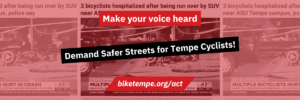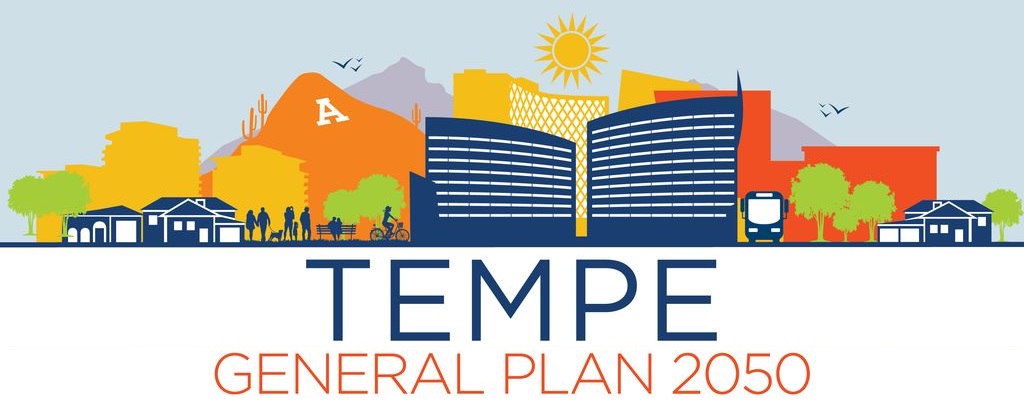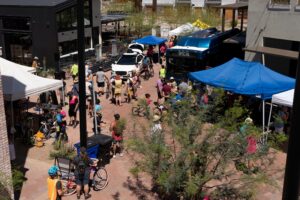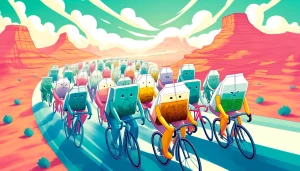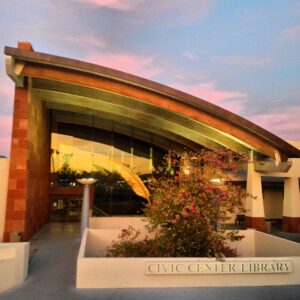2024 Tempe Active Transportation Survey
Key Findings
Need for Protected Bike Lanes: Cyclists emphasized the urgent need for protected bike lanes on major roads like Rural Road, Apache Boulevard, and Southern Avenue to enhance safety.
Continuous Infrastructure: Respondents highlighted the importance of continuous and uninterrupted bike lanes, particularly around intersections, to ensure safer and more efficient travel.
Maintenance Concerns: Cyclists called for better road maintenance, including repaving damaged surfaces and removing debris from bike lanes, to ensure safer cycling conditions.
Community Support for Amenities: There is strong support for adding amenities like water stations, seating, and shade along popular cycling routes, such as canal paths and key streets like College Avenue and Hardy Drive.
1.1 How would you rate the current condition of the bicycle lanes and active transportation paths in Tempe?
1.2 What is your favorite route to bike in Tempe? Why?
While there’s no dominant single favorite, there seems to be a preference for routes that offer safety features like separation from vehicle traffic and naturalistic or scenic qualities. Frequently mentioned routes include:
- Canal Paths: Several responses mentioned the canal paths, such as the Western Canal for their open and quiet characteristics.
- Tempe Town Lake and Rio Salado: These areas were also mentioned multiple times, highlighted for being away from traffic and offering scenic views, safety, and well-maintained paths.
- College Avenue: This route was noted for its shade, some degree of protection and separation from traffic, and slower car speeds, making it a preferred choice for some cyclists.
1.3 Describe any safety issues you’ve experienced while cycling in Tempe?
Responses highlight a need for improvements in continuous bike lane coverage and better management of car traffic in cycling areas to improve safety and comfort for cyclists in Tempe. While responses were varied, some common themes emerged:
- Discontinuous Bike Lanes: Several respondents mentioned places where bike lanes abruptly end or do not continue through intersections, creating uncertain and potentially dangerous situations for cyclists.
- Car Interactions: There are frequent mentions of problems related to cars, such as vehicles turning right or left at intersections without yielding to cyclists, or cars parking in bike lanes, both of which pose significant risks.
- Protected / Separated Bike Lanes: A few responses indicated a general feeling of unsafety due to close proximity to cars, implying that the existing infrastructure may not provide sufficient separation between cyclists and vehicle traffic.
1.4 What is your number ONE priority for improving Tempe’s bicycle and active transportation infrastructure?
1.5 If you could improve the bicycling experience in ONE location, what and where would you prioritize? Why?
The top priorities for cyclists were:
- Rural Rd
- Bike Lane Protection: Many cyclists desire protected bike lanes along Rural Road due to high traffic volumes and unsafe conditions. They want separation between bicycles and motor vehicles to increase safety.
- Continuous Bike Lanes: Respondents emphasized a need for uninterrupted bike lanes connecting North & South Tempe. They find gaps along the road, particularly near busy intersections, which make it unsafe and challenging for cyclists to navigate.
- Improved Connectivity: There are calls for better connectivity on Rural Road, especially to major destinations such as the Tempe Community Complex and the Tempe Town Lake area. Cyclists want easier access to these places with direct, well-marked bike lanes.
- Intersection Safety: Specific intersections, such as those at University Drive and Apache Boulevard, are highlighted as needing enhanced safety measures. This includes clearer markings and signals for bikes, to avoid conflicts with turning vehicles.
- Road Surface and Maintenance: Cyclists noted poor road conditions, including cracks and debris, and are requesting better maintenance to ensure safer travel along Rural Road.
- Apache Blvd
- Protected Bike Lanes: Similar to Rural Road, respondents mentioned the need for protected or separated bike lanes on Apache.
- Continuous Infrastructure: Cyclists noted gaps in the bike lanes, particularly around intersections, which create dangerous situations. They want continuous bike lanes along Apache that connect seamlessly to other paths and areas.
- Intersection Safety: Key intersections on Apache, like those with Rural Road and the 101 Freeway, were identified as particularly hazardous. Respondents want improved safety measures, such as better markings, signals, and barriers to protect cyclists from vehicle conflicts.
- Road Maintenance and Surface Conditions: Poor road conditions were noted, including cracks and debris, making cycling hazardous. Improved maintenance and resurfacing are requested to ensure smoother travel.
- Traffic Calming: Respondents suggested traffic calming measures to slow down vehicles and raise awareness for vehicles entering the roadway from driveways and parking lots
- Southern Ave
- Complete Protected Bike Lanes: Respondents emphasized the need to extend bike lanes along Southern Avenue. With high vehicle traffic on this major road, cyclists are calling for protected bike lanes to ensure safe travel, separated from cars and other motor vehicles.
- Traffic Calming Measures: Traffic calming measures are sought to reduce vehicle speeds to the posted speed limit and make cycling safer along this busy thoroughfare.
- Improved Maintenance: Some respondents noted the need for better maintenance, such as repaving damaged surfaces and removing debris to make bike lanes more usable and safe.
- Crosswalk Improvements: Several respondents highlighted dangerous intersections, recommending improved crosswalks and clear signals to make crossing safer for cyclists and pedestrians.
- Alameda Dr
- UPRR Crossing: Respondents are calling for improving this crossing to remove bollards and introduce a signalized crossing so that cargo bikes, recumbent bikes, and other wider active transportation vehicles are able to cross.
- Loop 101 Crossing: Several respondents also requested a pedestrian / cycling bridge across Loop 101 to better connect neighborhoods and ensure respondents are not diverted to the high volume Broadway crossing
1.6 How does heat impact your cycling choices?
Overall, the responses highlight the significant impact of high temperatures on cycling habits and the need for better infrastructure to mitigate these challenges:
- Timing Adjustments: Many cyclists prefer riding early in the morning or late in the evening to avoid the hottest parts of the day. Some cyclists specifically mentioned cycling before dawn or after sunset.
- Reduced Frequency or Distance: Several respondents limit their cycling during hot months, reducing recreational rides or switching to shorter commutes. Many avoid riding when temperatures exceed certain thresholds (e.g., 90°F, 100°F, or 105°F).
- Prioritizing Shade: Cyclists often seek shaded routes or paths, even if that means choosing streets with poorer conditions. Some wish for more shade along paths and at bike racks.
- Alternative Transportation: During extreme heat, some respondents rely on public transportation, ride-hailing services, or use an electric bike to reduce physical exertion.
- Hydration and Clothing: Staying well-hydrated is a high priority, and many respondents adjust their clothing, carrying extra outfits to change into at their destination.
- Environmental Factors: Several cyclists are concerned about urban heat islands, and wish for more water refill stations and greenery along bike paths.
1.7 What locations would benefit from “hub” amenities such as water stations, seating, shade and trees?
- Canal Paths: Many respondents mentioned various canal paths like the Western Canal, Sun Circle Trail, and Rio Salado pathways. They emphasized a need for more water stations, shade, and resting points along these routes.
- Tempe Marketplace Area: Several cyclists noted the potential for a “hub” around Tempe Marketplace, especially near the river path. They envision this area as a key biking junction where amenities could serve both cyclists and pedestrians.
- Broadway & Rural: Identified for shade and resting amenities.
- College Avenue: This street is noted for its high traffic and need for more shade and resting areas.
- Hardy Drive: As a key north-south route, respondents think Hardy would benefit from water stations and shade.
- Airport and Papago Park Trails: These are considered important recreational biking paths that would benefit from increased amenities.
- Transit and Bus Stops: Several responses suggested areas near Orbit flag zones could use water stations and shaded seating to encourage multimodal transport.
- Other Ideas: Dog-friendly water stations for multi-use paths. Improved signage and knowledge sharing for bathroom and water station locations, particularly for new cyclists.
1.8 Which policies or programs would you support to enhance cycling in Tempe?
2.1 Are you registered to vote?
2.2 Do you consider cycling infrastructure policies when voting?
2.3 Please describe any advocacy or volunteer work related to cycling you’ve participated in?
Survey responses reveal a broad range of involvement:
- Community and Event Participation:
- Tempe Bicycle Action Group (TBAG): Many respondents are involved with TBAG, participating in bike counts, community events, valet services, and other advocacy initiatives.
- Bike Saviours: A common theme among respondents is volunteering with Bike Saviours for repair workshops and club activities.
- Tour de Fat: Several participants have volunteered for this popular cycling event.
- Advocacy and Campaigning:
- Some respondents have directly advocated for improved infrastructure, including protected bike lanes on streets like Smith Road.
- Participation in the National Bike Summit and local advocacy through the Arizona Bicycle Summit is mentioned.
- A few lead council candidate rides and work with council members on advocacy.
- Research and Surveys: Many have contributed to bike counts, surveys, and city meetings to provide data and feedback for cycling infrastructure improvements. They also participate in online comment periods.
- Safe Routes to School: Some respondents worked on promoting safer cycling routes for students commuting to school.
- Workplace Initiatives: Some work on bike commuting efforts through their employers. Involvement with Arizona State University’s biking initiatives is also noted.
3.1 What is your age range?
3.2 What is your zip code?
3.3 How often do you use bicycle or active transportation (walking, scooters, e-bikes etc.) in Tempe?
3.4 What are your primary reasons for cycling or using active transportation?
3.5 What advice would you give new cyclists in Tempe?
Safety Awareness
- Stay Vigilant: Keep your head on a swivel and be aware of surroundings, particularly around ASU and in areas without bike lanes.
- Assume Invisibility: Assume that cars do not see you and act cautiously.
- Watch Intersections: Even with green lights, double-check for traffic before crossing.
Equipment and Gear
- Helmets: Wear a helmet every time.
- Bright Clothing: Wear bright or neon colors during the day, and use bright lights at night.
- Locks: Invest in a good lock to prevent bike theft.
Route Planning
- Safe Routes: Prefer backroads, low-traffic streets, and canal paths over main roads and arterials.
- Mapping Tools: Use tools like Google Maps and Strava to find safe routes.
- Public Transit: Use the orbit bus system for help during hot months or longer commutes.
Hydration and Maintenance
- Hydrate: Carry plenty of water, especially in hot weather.
- Basic Repairs: Learn to change tubes and consider adding sealant to prevent punctures.
Community Engagement
- Join Groups: Engage with groups like Bike Saviours and TBAG for support and fun rides.
- Advocacy: Get involved with advocacy organizations working to make cycling safer.
- Have Fun: Cycling in Tempe is enjoyable and rewarding. Get out there and ride!
3.6. Please provide any additional comments or suggestions for improving cycling in Tempe:
Infrastructure Improvements:
- Protected Bike Lanes: Strong calls for more protected bike lanes, especially on major roads like Apache Boulevard and University Drive.
- Network Expansion: Cyclists want a more comprehensive and connected network, filling in gaps and linking major destinations like shopping centers and grocery stores.
- Wayfinding and Signage: Improved signage and maps on trail networks are suggested to enhance navigation and awareness.
- Car-Free Streets: Several respondents envision more car-free streets downtown and reducing cars in the urban core.
Safety Measures:
- Traffic Laws: Calls for stricter enforcement against excessively loud vehicles, distracted driving, and legal consequences for drivers at fault in bike accidents.
- Left Turn Safety: Suggestions to remove left turns on red lights to improve safety at intersections.
Amenities
- Incentives: Suggestions include offering discounted bus/rail passes for cyclists to support multi-modal transportation.
- Water Stations and Lighting: More water stations and improved lighting at key crossings, especially near Kiwanis Park.
- Bike Park: Requests for a dedicated bike park, pump track or BMX facilities.
